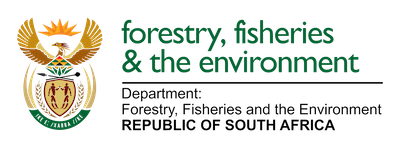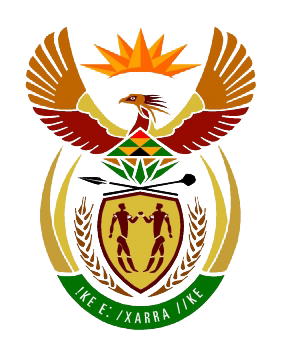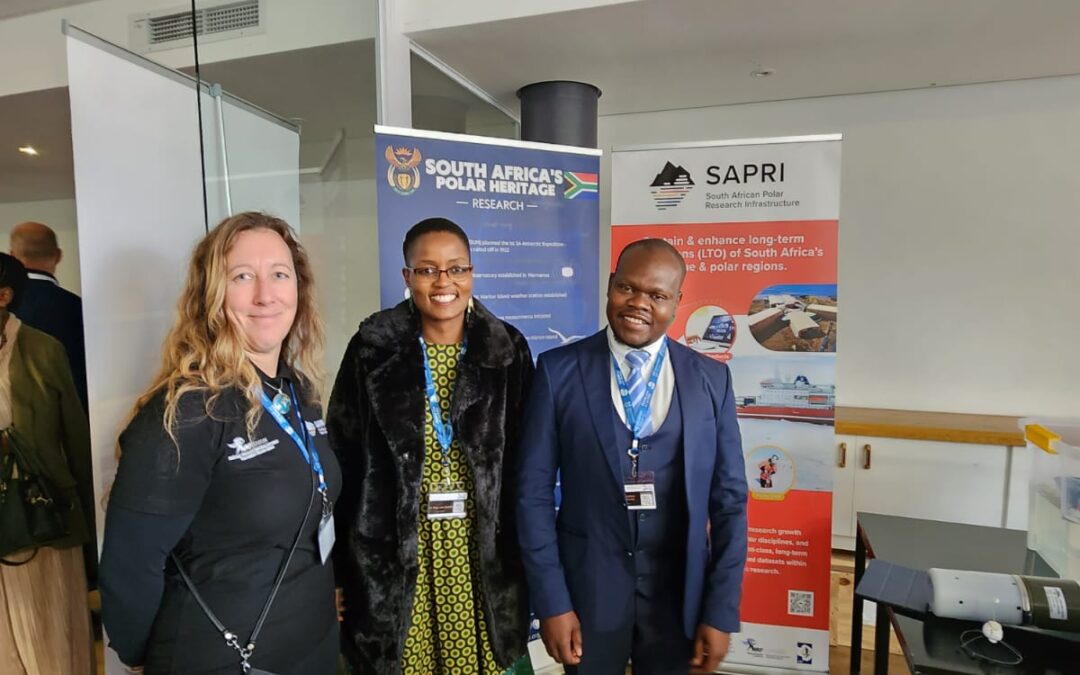
by Ria Olivier | Sep 9, 2023 | Announcement, Antarctica, Gough Island, News, Research, SA Agulhas II, SA Polar Research Infrastructure, SANAE IV, SANAP, SAPolarRI, SAPRI, Science, SEAmester, Southern Ocean, Stations, STEM
The South African Environmental Observation Network (SAEON) is a business unit of the National Research Foundation (NRF).
NRF SAEON celebrated its 21st anniversary on 7 September 2023. See the event programme below.
It is inspiring to see what SAEON has achieved over 21 years. “SAEON encompasses seven Research Nodes throughout South Africa and a National Office that is located in the country’s political capital of Pretoria” (Read more about the nodes here).
SAEON manages three research infrastructures developed by the Department of Science and Innovation (DSI) as part of the South African Research Infrastructure Roadmap (SARIR). The South African Polar Research Infrastructure (SAPRI) is one of the three research infrastructures, and was established in 2021 (see the SAPRI timeline here). The SAPRI hub is located in the SAEON Egagasini Node offices in Cape Town.
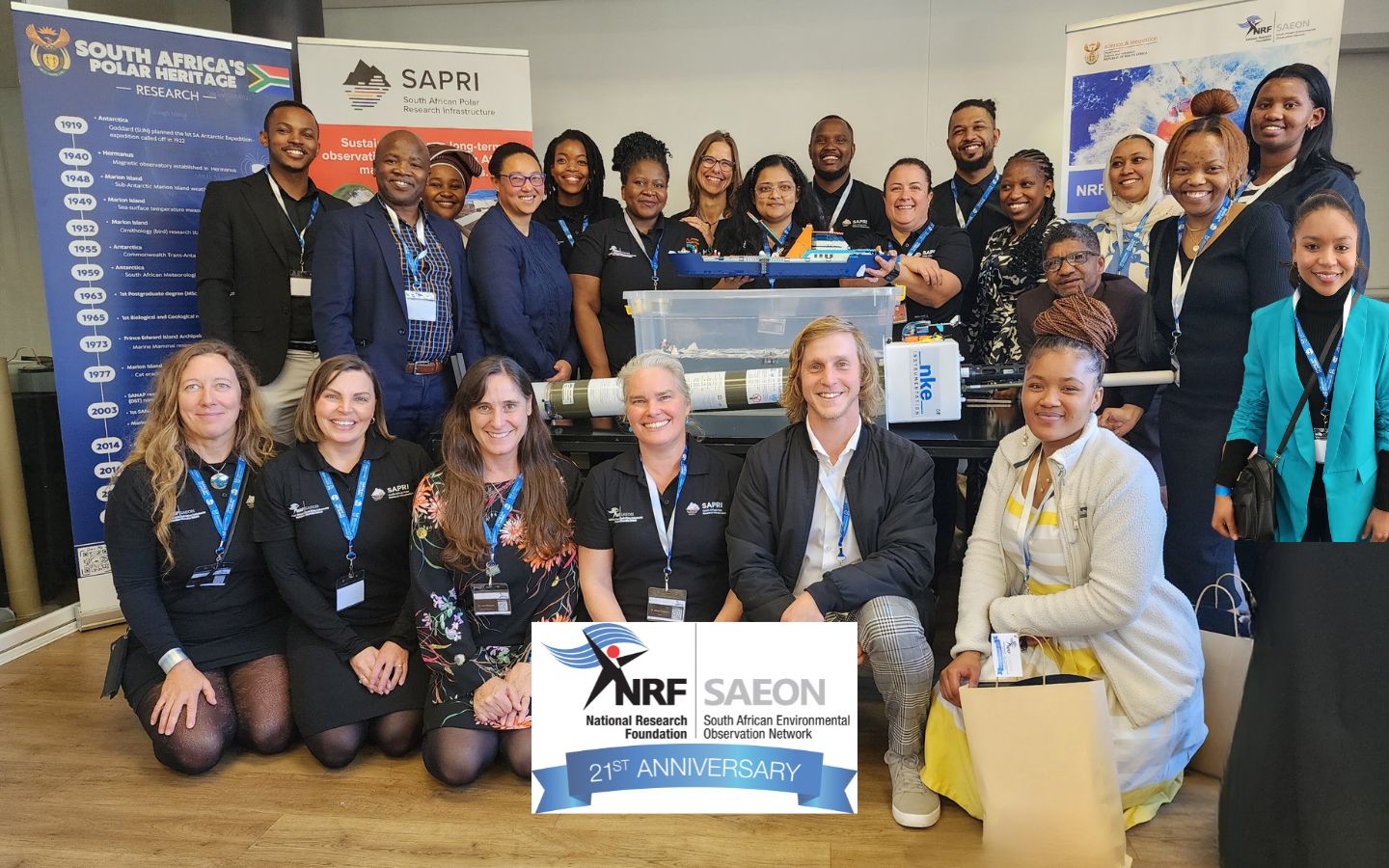
The SAEON Egagasini Node and SAPRI team at the NRF SAEON 21st Anniversary. Video: click on the image.
Anche Louw, South African Polar Research Infrastructure, 09 September 2023

by Ria Olivier | Aug 25, 2023 | Antarctica, Legacy, Marion Island, News, Prince Edward Islands, Research, SA Agulhas II, SA Polar Research Infrastructure, SANAE IV, SANAP, SAPolarRI, Science, Southern Ocean, Stations, STEM, sub-Antarctic
The South African Polar Research Infrastructure (SAPRI) with the Antarctic Legacy of South Africa (ALSA) and the South African Environmental Observation Network (SAEON) Egagasini Node visited Generation Schools Imhoff, in Kommetjie on 20 July 2023.

Generations Primary is based on the Montessori ethos of independent children working and the Cambridge model of education. The school structure consists of various phases with mixed-age groupings “which allows children to work together, to learn from and teach each other.” The mixed-age group 9 – 12 years has recently completed projects and tasks related to the Antarctic environment, creating a space where learners can develop, in a creative way, a sense of the 7th continent. The invite to visit the school to further connect the application of academics in the real world was welcomed.
The 110 learners with teachers, were presented with a rhythmic exercise with boom-whackers (musical plastic tubes) as an ice-breaker activity, which was followed by a “Journey through the Southern Ocean, via Marion Island, to Antarctica”, which was presented by Ria Olivier (ALSA), Sikelelwa Mtyenene (SAEON Egagasini Node), Abuyiselwe Nguna (SAPRI) and Riesna R. Audh (SAPRI). Various interactive exhibits were set up in the school hall, which further gave learners the opportunity to interact with the ALSA, SAPRI and SAEON teams.
“Journey through the Southern Ocean, via Marion Island, to Antarctica”
Follow the journey below.
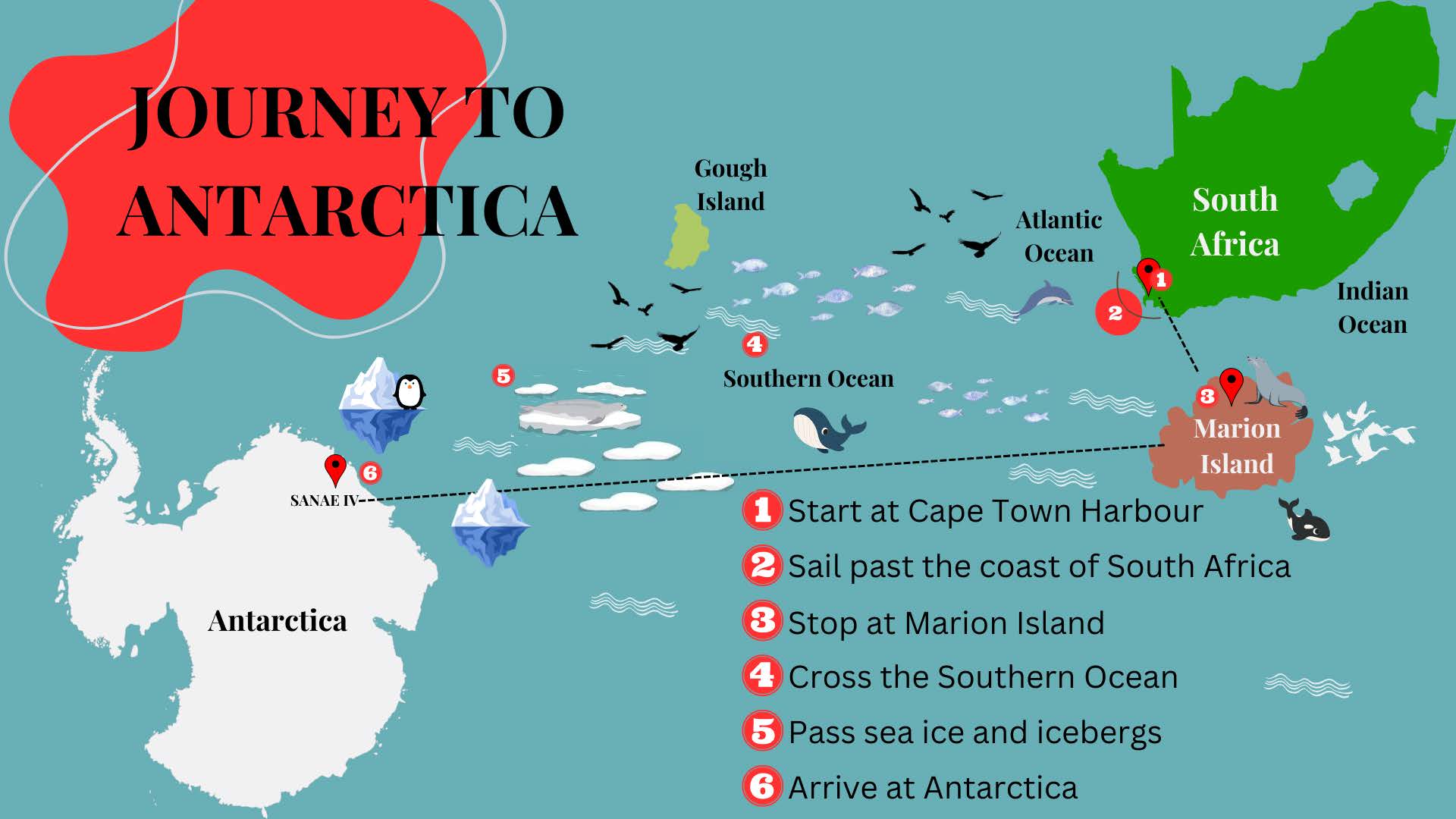
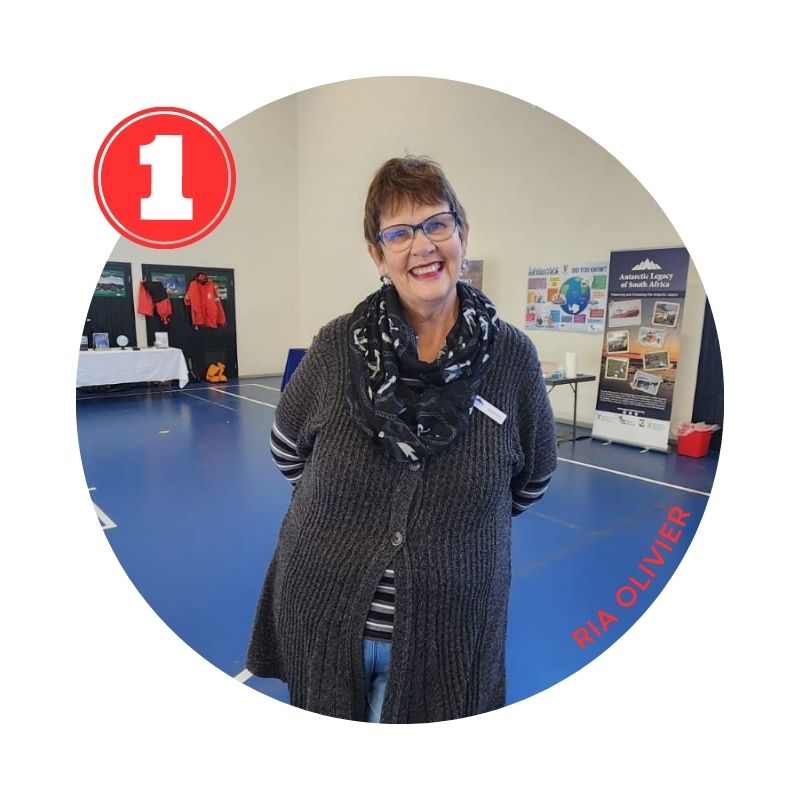 | Start at Cape Town Harbour - Ria Olivier
History: Archivist with 10 years' involvement in SANAP and Principal Investigator of the Antarctic Legacy of South Africa project, talks about South Africa's involvement in the Antarctic regions. |
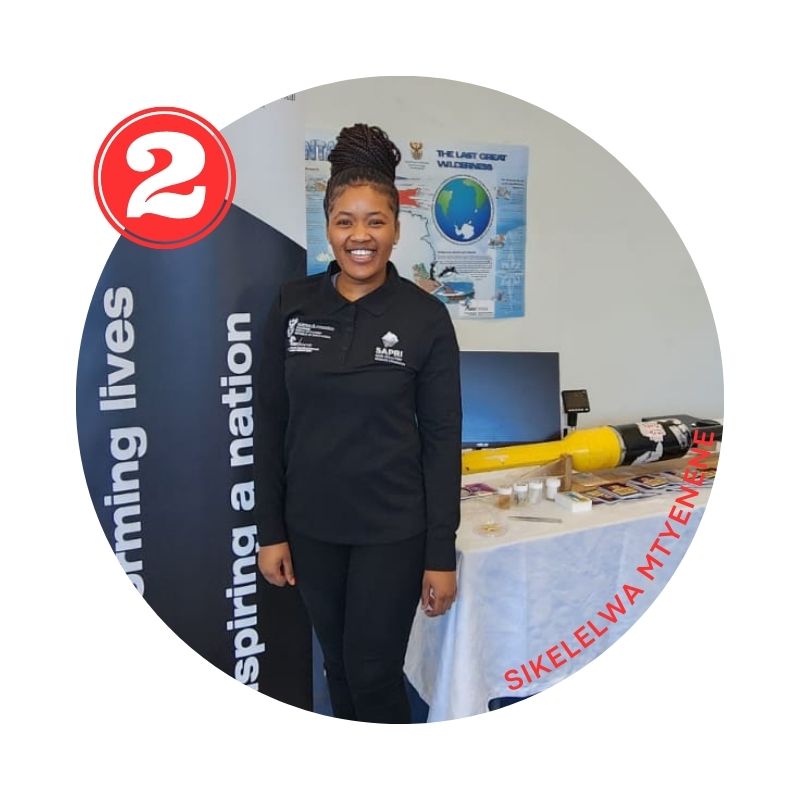 | Sail past the coast of South Africa - Sikelelwa Mtyenene
Coastal voyage: research conducted in the coast off South Africa, where the Atlantic and Indian oceans meet. |
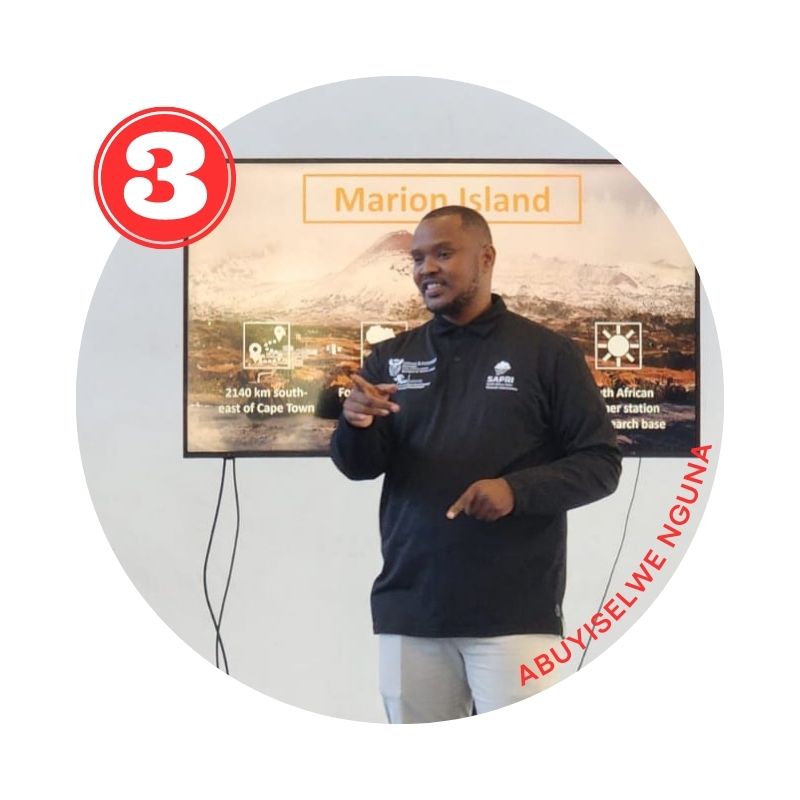 | Stop at Marion Island - Abuyiselwe Nguna
Science weather, fauna and flora. The speaker shares his experience as a field assistant, part of a Marion Island overwintering team member. |
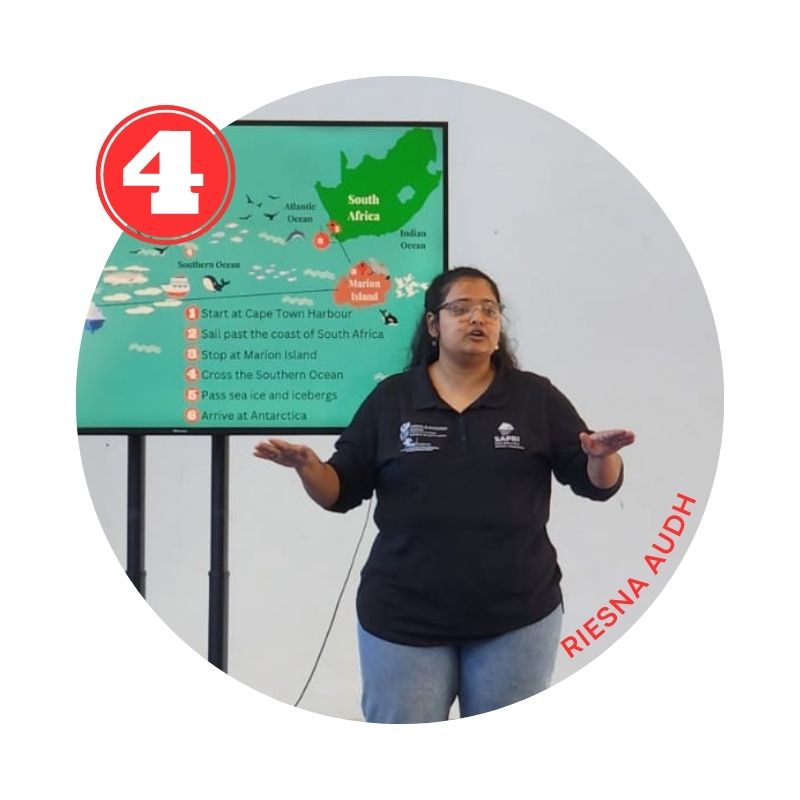 | Cross the Southern Ocean - Riesna Audh
Oceanographic sampling on board the South African research and supply vessel, the S.A. Agulhas II. |
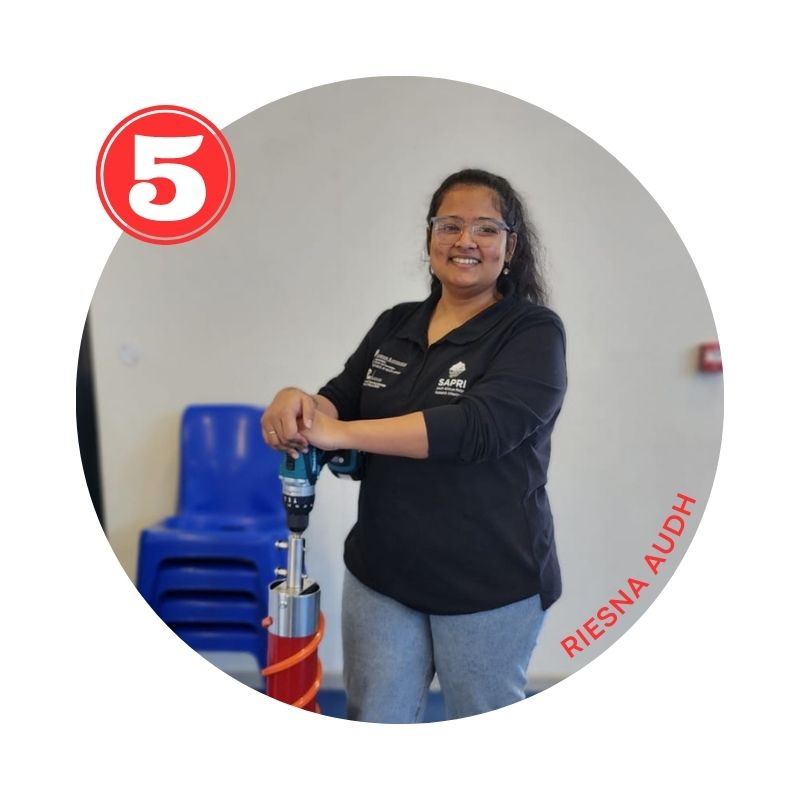 | Pass seaice and icebergs - Riesna Audh
The speaker has been on board the S.A. Agulhas II during various Antarctic expeditions (counting to over 300 days in total), for her research on sea ice in the Antarctic marginal ice zone. She shares her experiences. |
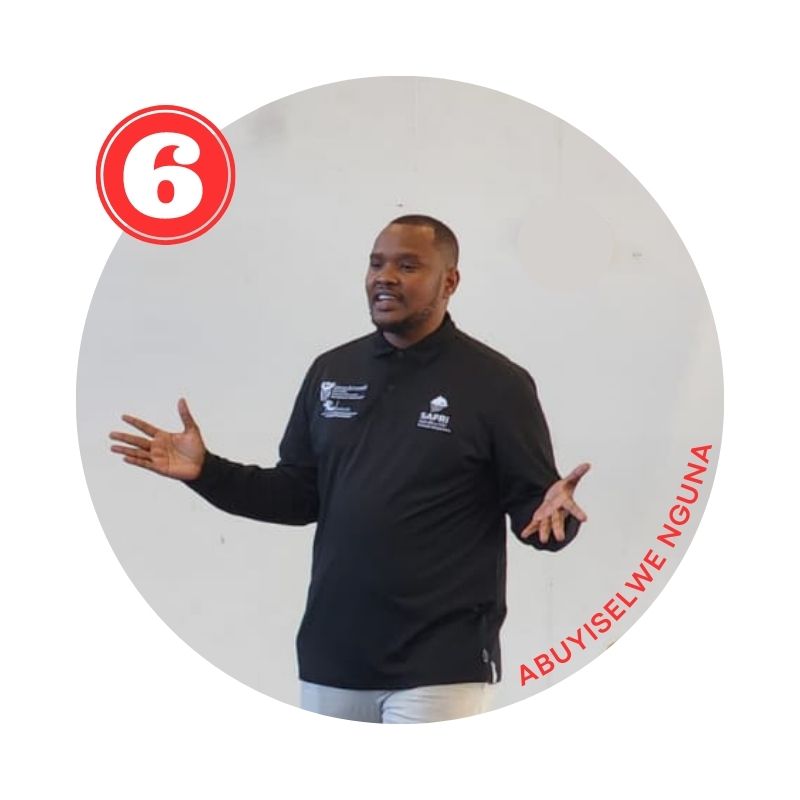 | Arrive at Antarctica - Abuyiselwe Nguna
What you can expect. Antarctic operations. Clothing (protective gear) and more info about the South African National Antarctic Expedition station (SANAE IV). |
Interactive exhibits
This collaborative science engagement event was focused on communicating marine and Antarctic research in such a way to foster curiosity for these regions. The school also received a set of books sponsored by the Antarctic Legacy of South Africa (see image below).
Video: Leaving fingerprints on Antarctica.
Graphic element (Journey to Antarctica) designed by: Riesna R. Audh, SAPRI, Polar Lab.
Anche Louw, South African Polar Research Infrastructure, 25 August 2023.

by Ria Olivier | Jul 17, 2023 | Announcement, Antarctica, Gough Island, Marion Island, Prince Edward Island, Prince Edward Islands, Research, SA Agulhas II, SA Polar Research Infrastructure, SANAP, SAPolarRI, SAPRI, Science, Southern Ocean, Stations, STEM, sub-Antarctic
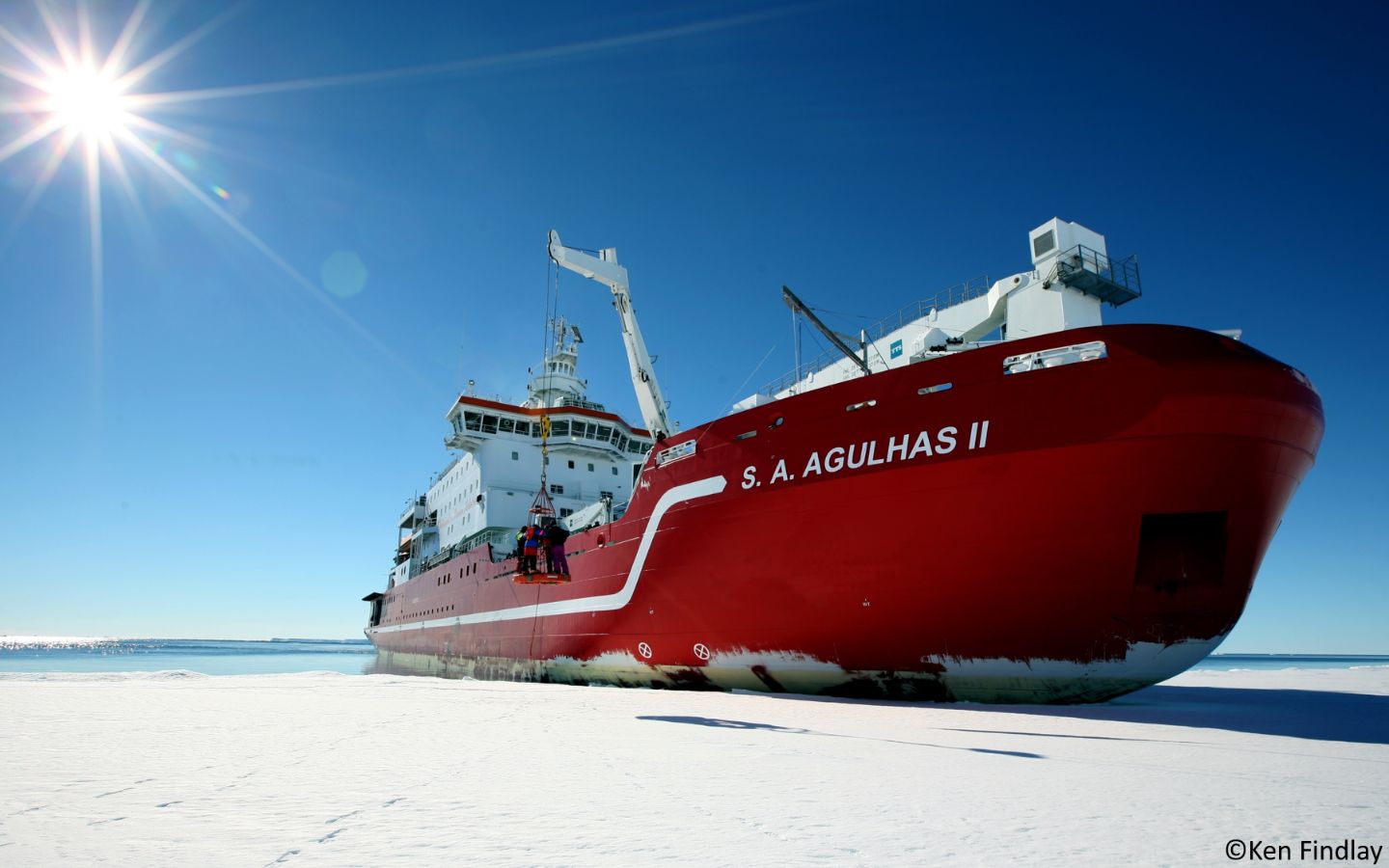
In 2015, The Department of Science and Technology (DST) facilitated the first dedicated oceanographic winter expedition on the S.A. Agulhas II from 23 July – 14 August 2015. The success of this expedition and others that followed demonstrated the need expressed by the wider marine and Southern Ocean research community and has prompted the DSI to secure funds for additional dedicated research expeditions in 2024, 2025 and 2026. The number of dedicated research expeditions will depend on the need expressed and the funding available. The core objective is to develop a comprehensive marine and Antarctic research expedition plan for 2024-2026, underpinned by the Marine and Antarctic Research Strategy (MARS) and contributing to the United Nations Decade of Ocean Sciences for sustainable development. These dedicated research expeditions will not only encompass oceanography but will provide research opportunities for marine-related and South African National Antarctic Programme (SANAP) –related research.
MARS was developed to provide a platform from which to coordinate marine and Antarctic research. The assumption is that improved coordination of a currently fragmented science system will improve returns on investment. Structured planning and a guided strategic focus will maximize human capital development and bring South Africa to the international forefront of knowledge production in these research areas. From this will follow innovation, increased international influence, and ultimately, economic growth.
The NRF and the South African Polar Research Infrastructure (SAPRI) have been tasked with coordinating various activities that will feed into improved planning and coordinating of marine and Antarctic research activities. As such, the NRF together with SAPRI would like to maximise on the opportunities for dedicated expeditions based on research community needs to enable long-term planning for expeditions, including sourcing funding for such expeditions. Dedicated expeditions may be implemented in periods where the S.A. Agulhas II is available. The schedule for the annual relief voyages indicate periods when the S.A. Agulhas II is not available (relief voyages for Antarctica, Marion Island and Gough Island). The direction (expedition transects), duration (including number and types of stations) and research focus of each dedicated research expedition would then be decided on by the DSI, together with the NRF, based on such variables as proposed participation, research area alignment, MARS theme alignment, contribution to the Ocean Decade and overall return on investment (data collection and capacity development.). To this end, SAPRI can support the costs of any in person meetings required to discuss collaborative research expeditions.
It should be noted that the attached annexure may change depending on the activities of the Department of Forestry, Fisheries, and the Environment (DFFE). For example, an emergency may require DFFE to deploy the S.A. Agulhas II to enable the Department of Public Works to do building maintenance and repairs at any of the three bases. As such, all potential dedicated expeditions will need to be approved by the DFFE before final planning can begin.
Please complete the template and return to tj.klarenbeek@risa.nrf.ac.za no later than 15 August 2023. The completed templates will give an indication of research community demand. More detailed research plans will be requested hereafter.
Expression of interest – dedicated S.A. Agulhas II voyages
Text: Expression of interest, Participation in dedicated research expeditions 2024, 2025, 2026. Tracy Klarenbeek, Director: Knowledge Advancement and Support (KAS), National Research Foundation (NRF), Research Innovation Support and Advancement (RISA).

by Ria Olivier | Sep 27, 2022 | Announcement, Antarctica, Legacy, Research, SANAP, SANAP Student, Science, STEM
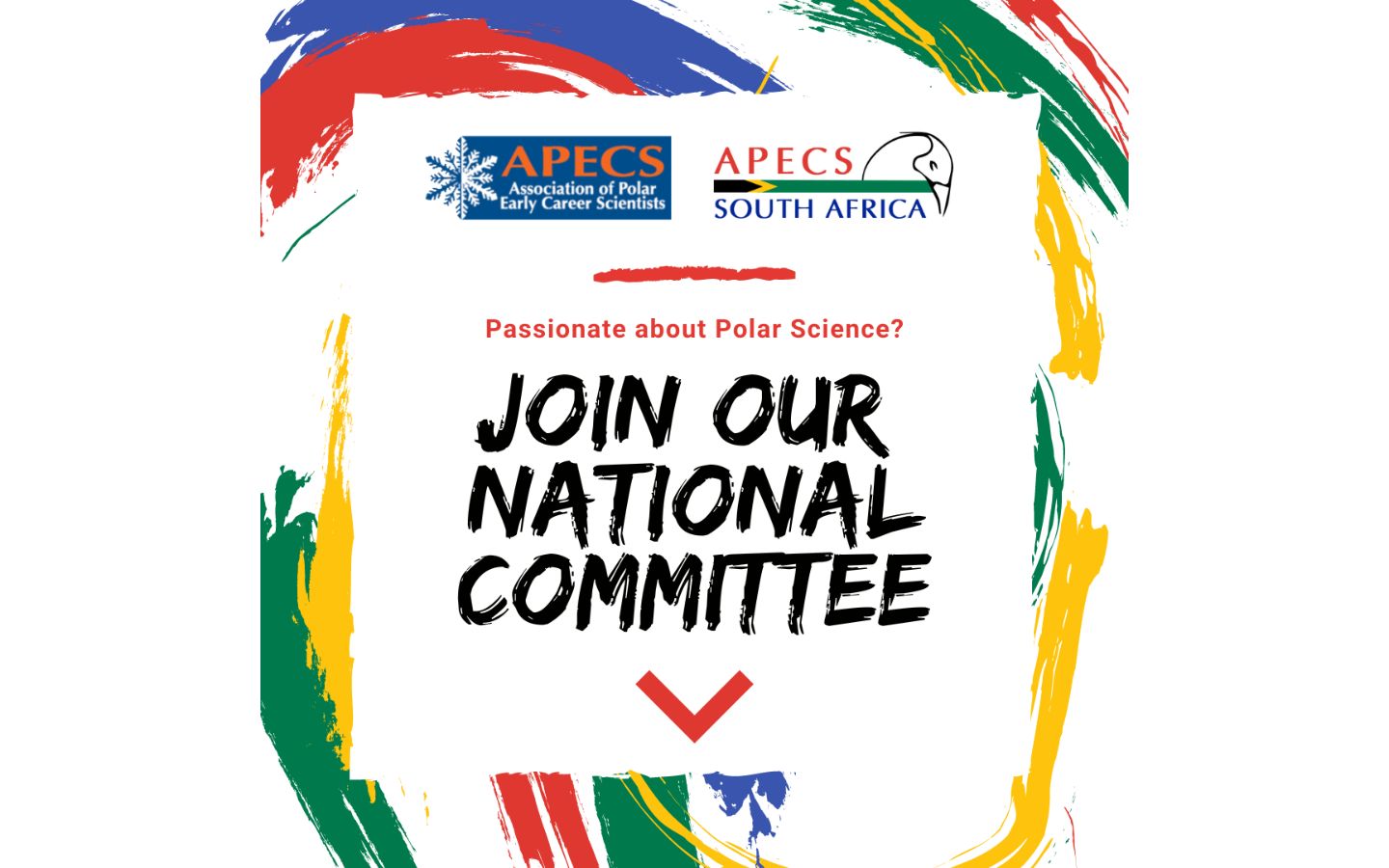 Applications are now open to join the national committee of APECS-SA, the South African National Committee of APECS (Association of Polar Early Career Scientists).
Applications are now open to join the national committee of APECS-SA, the South African National Committee of APECS (Association of Polar Early Career Scientists).
APECS-SA is looking for early career scientists, enthusiasts, naturalists, and good storytellers passionate about Polar Research, to join the team.
As polar researchers, we are responsible for communicating the value of polar research, and APECS-SA needs your help!
If you are not an APECS member yet, join APECS-SA today and apply to be on the National Committee.
Application deadline: 31 October 2022
Apply here!
The current National Committee
Read more about the NC members
Read more about APECS-SA

by Ria Olivier | Jul 29, 2022 | Antarctica, Current Event, Research, SA Agulhas II, SA Polar Research Infrastructure, SANAP, Science, Southern Ocean, STEM
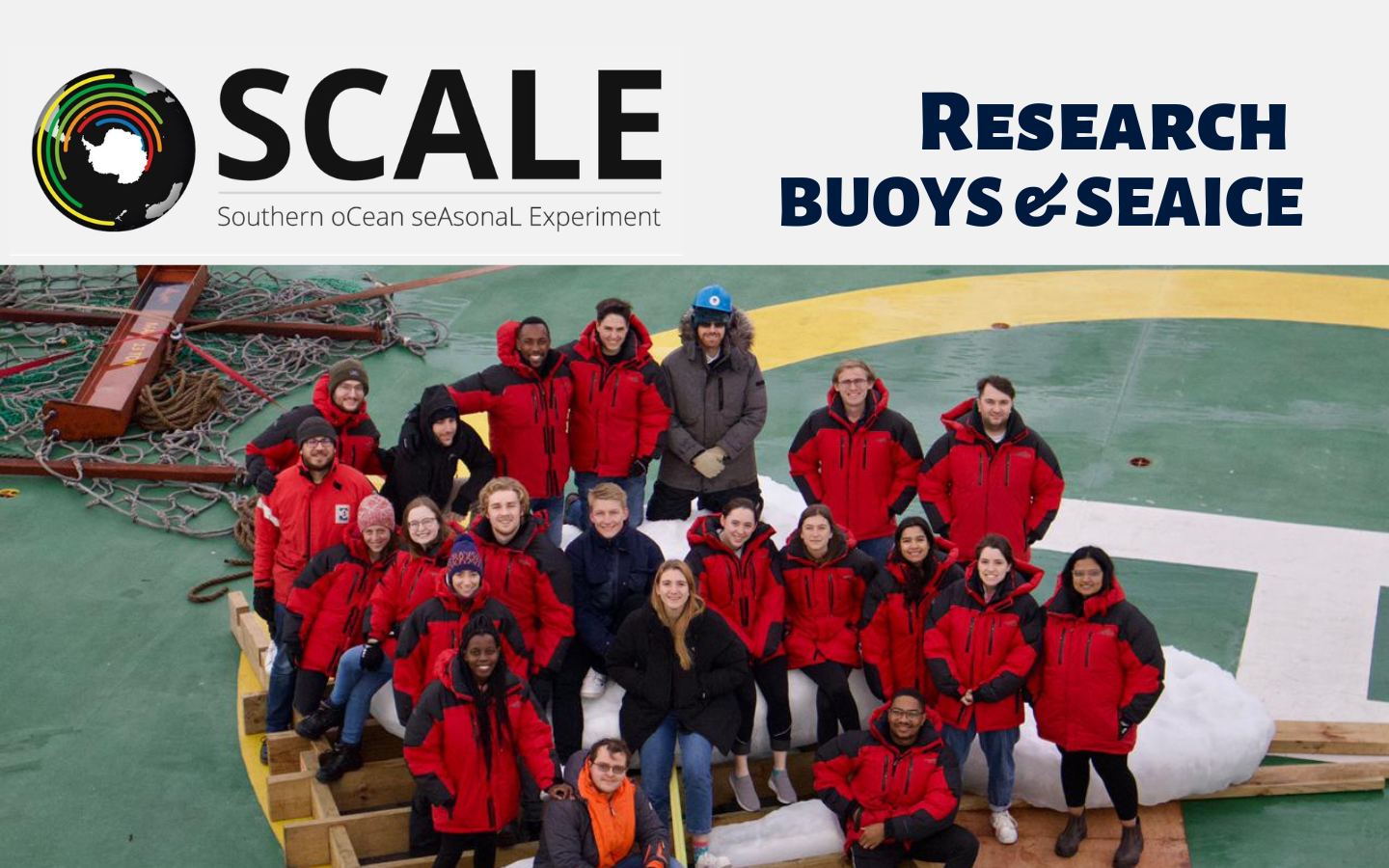
Team Buoys, team SEAICE and the logistics personnel involved in ocean operations.
| TEAM | BUOYS |
| Project name | A network of autonomous sea ice observation platforms in support of Southern Hemisphere climate predictions |
| Principal Investigator & Onboard Team Leader | Robyn Verrinder | University of Cape Town, Marine and Antarctic Research centre for Innovation and Sustainability (UCT-MARIS)
|
| Principal Investigator & ship based Chief Scientists of SCALE-WIN22 | Marcello Vichi | University of Cape Town, Marine and Antarctic Research centre for Innovation and Sustainability (UCT-MARIS)
|
| TEAM | SEAICE |
| Project name | Mechanical and biogeochemical properties of sea ice. |
| Principal Investigator | Tokoloho Rampai | University of Cape Town, Marine and Antarctic Research centre for Innovation and Sustainability (UCT-MARIS)
|
| Principal Investigator | Marcello Vichi | University of Cape Town, Marine and Antarctic Research centre for Innovation and Sustainability (UCT-MARIS)
|
Onboard BUOYS team members:
| Team Member | Role | Affiliation |
| Robyn Verrinder | Onboard Team Leader | University of Cape Town |
| Michael Noyce | MSc | University of Cape Town |
| Agoritsa Spirakis | MSc | University of Cape Town |
| Lawrence Stanton | MSc | University of Cape Town |
| Justin Pead | Senior Tech Officer | University of Cape Town |
| Ippolita Tersigni | PhD | University of Melbourne (Australia) |
| Giulio Passerotti | PhD | University of Melbourne (Australia) |
| Jacques Welgemoed | PhD | Nelson Mandela University |
| Francesca de Santi | Research fellow | University of Cape Town |
| Jan-Victor Björkqvist | Researcher | Finnish Meteorological Institute (Finland) |
| Alberto Alberello | Senior Research Associate | University of East Anglia (U.K) |
Onboard SEAICE team members:
| Team Member | Role | Affiliation |
| Siobhan Johnson | Onboard Team Leader | University of Cape Town |
| Felix Paul | Technician/PhD | University of Cape Town
University of Duisburg-Essen (Germany) |
| Safiyyah Moos | PhD | University of Cape Town |
Tamuka Keche
| MSc | University of Cape Town |
Hayley Swait
| MSc | University of Cape Town |
Magata Mangatane
| PhD | University of Cape Town |
Lisa Kumadiro
| MSc | University of Cape Town |
Dayna Collins
| Honours | University of Cape Town |
Onboard ocean operations logistics team:
| Team Member | Role | Affiliation
|
| Riesna R. Audh | Ice operations | University of Cape Town |
| Jonathan Rogerson | Ocean operations | University of Cape Town |
| Ashleigh Womack | Sea ice operations | University of Cape Town |
BUOYS: More about the project and the team:
A variety of synoptic, seasonal and interannual drivers influence the forms, types and concentration of sea ice in the Marginal Ice Zone (MIZ) in the Southern Ocean. The temporal and spatial distribution of the ice and its physical, mechanical and biological properties are directly related to the natural variability of the oceans and atmosphere, but also anthropogenic climate change. Climate and Earth System Models have limited sea ice variable parameterisations due to the scarcity of spatially distributed high resolution measurements from the region, specifically during winter/spring. To better understand atmosphere-ice-ocean MIZ processes and to improve future prediction of seasonal sea ice coverage and extent, three main approaches are available: (1) in situ measurements, (2) area-wide satellite data, and (3) numerical and experimental modelling. The meaningful connection of these is essential for enhancing understanding of this region.
Improved use of technology and autonomous devices, capable of persistent in situ sampling at finer spatial resolutions over the winter/spring seasons in the Antarctic MIZ, are key to obtaining the datasets needed to improve Earth System Models and to validate remote-sensing products. This requires a multidisciplinary approach including engineering, oceanography and climate science. The #SCALEwin22 expedition BUOY team comprises researchers and students from several institutes including the University of Cape Town (Robyn, Michael, Justin, Lawrence, Agoritsa and Francesca), Nelson Mandela University (Jacques), University of Melbourne (Guilio and Ippolita), University of East Anglia (Alberto) and the Finnish Meteorological Institute – FMI (Jan-Victor). During the expedition we aim to collect high-frequency wave and ice drift data using ice-tethered buoys (see images below) designed and built by the UCT team as well as open water buoys developed by Tallinn University of Technology and WiseParker OÜ. These measurements will be complimented by advanced ship-based imaging of ice floes and waves using LiDAR, stereo and thermal cameras. These unique high resolution data sets will be used to better characterise wave drivers of sea ice formation during winter and to inform Southern Hemisphere climate predictability.
SEAICE: More about the project
Analysis of structural, textural, and mechanical properties of sea ice in the Antarctic marginal zone.

Read more about the SEAICE team’s research here: UCT-MARiS
Check them out on Social Media:
Fearued Image: (Back) L-R: Jan-Victor Björkqvist (BUOYS), Giulio Passerotti (BUOYS), Alberto Alberello (BUOYS), Magata Mangatane (SEAICE), Robyn Verrinder (BUOYS), Justin Pead (BUOYS), Lawrence Stanton (BUOYS), Jacques Welgemoed (BUOYS); (middle) Francesca de Santi (BUOYS), Agoritsa Spirakis (BUOYS), Ippolita Tersigni (BUOYS), Michael Noyce (BUOYS), Felix Paul (SEAICE), Siobhan Johnson (SEAICE), Hayley Swait (SEAICE), Ashleigh Womack (Sea ice operations – logistics), Safiyyah Moos (SEAICE), Dayna Collins (SEAICE), Riesna Audh (ice operations – logistics); (front) Lisa Kumadiro (SEAICE), Jonathan Rogerson (ocean operations – logistics) and Tamuka Keche (SEAICE). Image Credit: Kurt Martin.
Images by Robyn Verrinder, Agoritsa Spirakis, Alberto Alberello and Kurt Martin (SAPRI trainee).
Buoys team text by Robyn Verrinder, Principal Investigator and onboard team leader.
Anche Louw, Antarctic Legacy of South Africa, 29 July 2022.
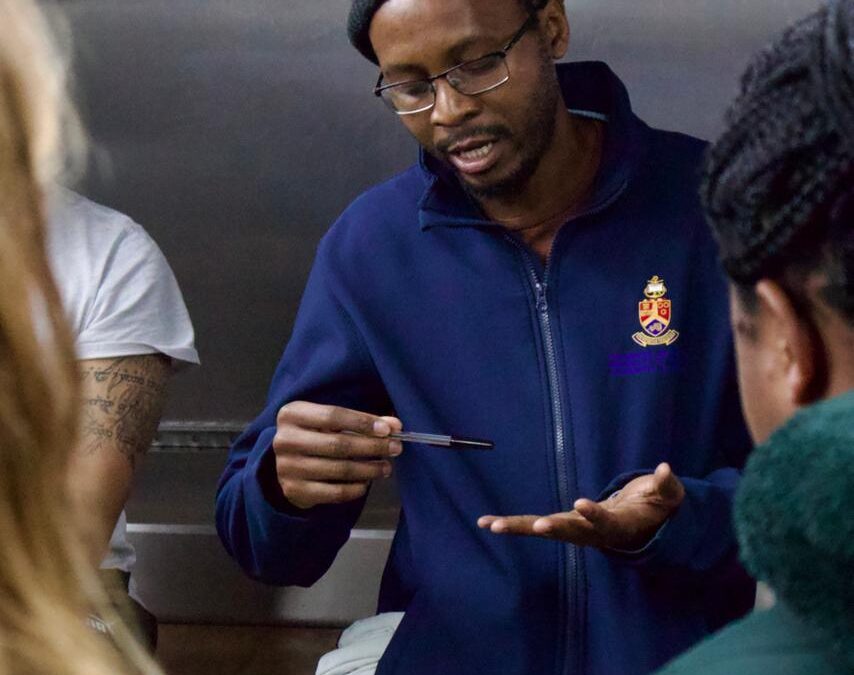
by Ria Olivier | Jul 28, 2022 | Antarctica, Research, SA Agulhas II, SANAP, Science, Southern Ocean, STEM
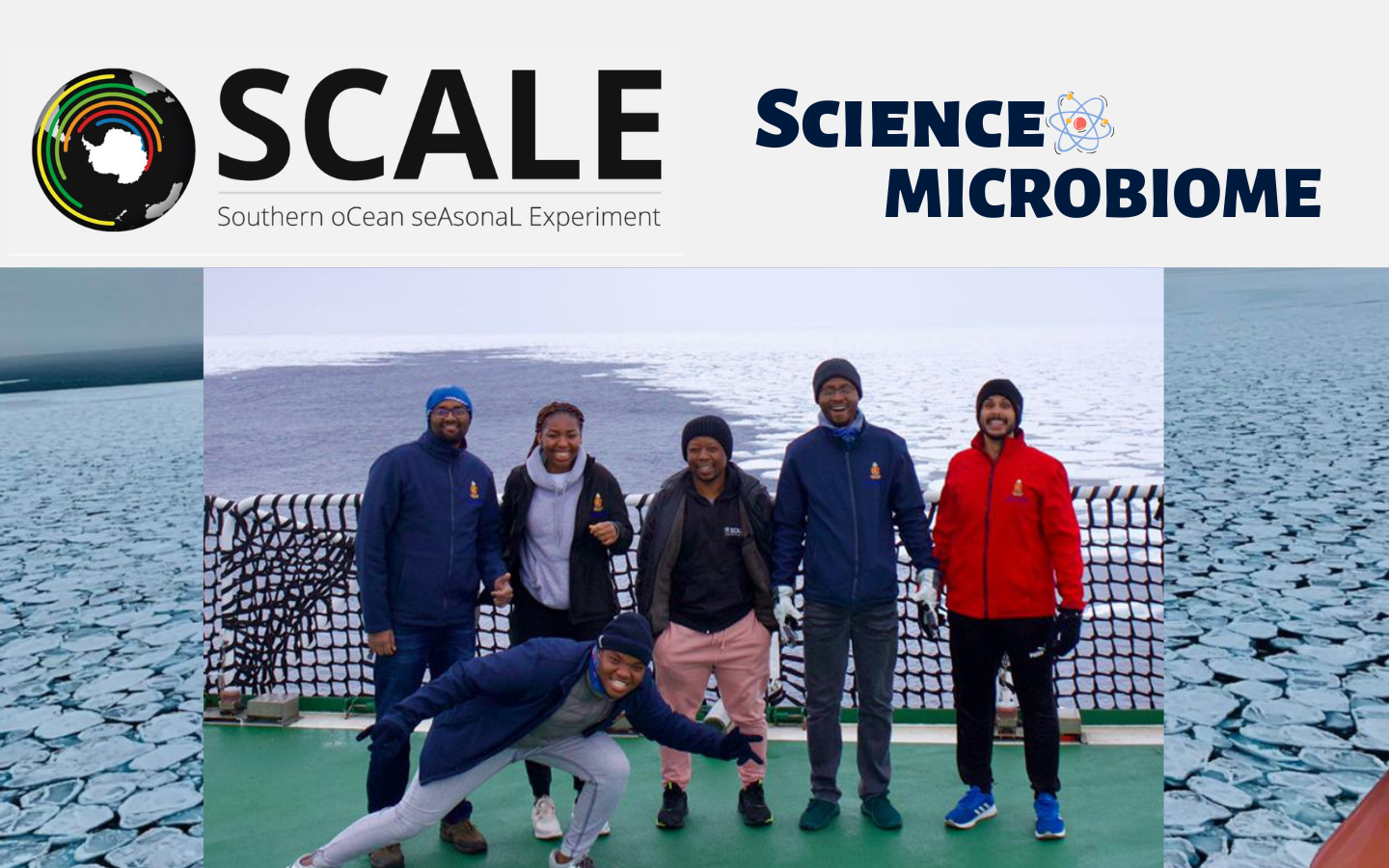
(L-R): Girish Rameshan, Nyasha Mafumo, Thato Mtshali (Team Leader of team FE), Oliver Mogase, Benjamin Abraham, Mayibongwe Buthelezi (front).
| TEAM | MICROBIOME |
| Project | Enhanced insights regarding the ecology, evolution and function of marine microbiomes |
| Principal Investigator | Thulani Makhalanyane | University of Pretoria |
Onboard team members:
| Team Member | Role | Affiliation |
| Oliver Mogase | Onboard Team Leader | UP |
| Mayibongwe Buthelezi | PhD | UP |
| Girish Rameshan | Postdoc | UP |
| Nyasha Mafumo | MSc | UP |
| Benjamin Abraham | PhD | UP |
The project description as per the sailing orders for the SCALE Winter Cruise of 2022:
By undertaking a temporal and seasonal evaluation of Southern Ocean (SO) microbiomes, we aim to provide insights regarding the diversity and function of their microbiomes. Taking advantage of current scheduled cruises and cruises of opportunity, we plan to explore key questions related to the selective forces shaping biogeographic distributions in the SO. We will explore microbial interactions using meta-omics analyses. Using the sequence data generated from our taxonomic and functional analysis of microbes in the SO we aim to provide insights regarding the ecology of geographically proximal marine waters.
We will use these data as a tool to understand microbial responses to environmental changes and their biochemical outcomes. To understand the effects of nutrients (trace elements) in shaping SO microbiomes, we will conduct a series of complementary experiments aimed at using a combination of coordinated sampling and ship-based co-limitation experiments. These studies will provide insights regarding the selective pressures shaping biogeographic and temporal distributions in the Southern Ocean. Understanding the adaptive responses of microbiomes, on the genome level, will allow us to predict the potential impacts of climate mediated changes on ecosystem services. Both these components are done in collaboration with the EU-H2020 project AtlantECO.
The MICROBIOME team set some time aside to explain their field of research to the South African Polar Research Infrastructure (SAPRI) trainees:
Follow the MICROBIOME team on Twitter!

Images supplied by Kurt Martin (SAPRI trainee).
Anche Louw, Antarctic Legacy of South Africa, 28 July 2022.


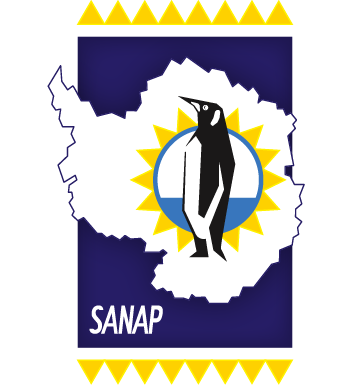












 Applications are now open to join the national committee of
Applications are now open to join the national committee of 





